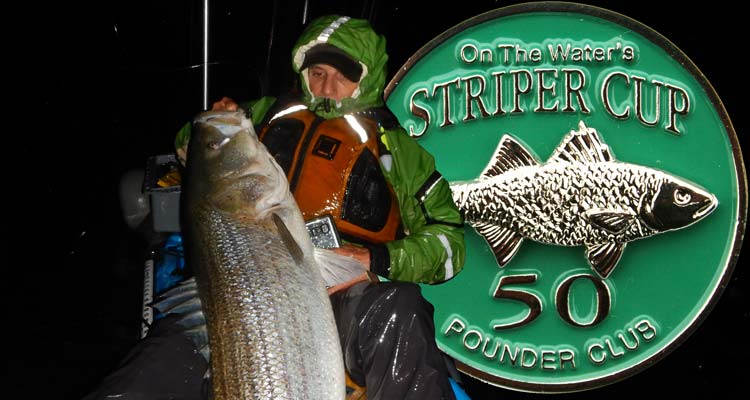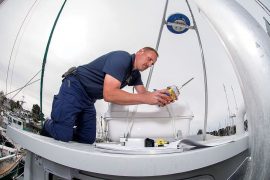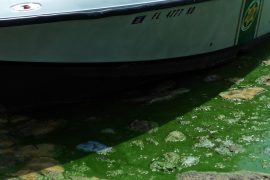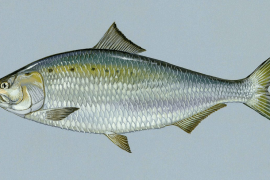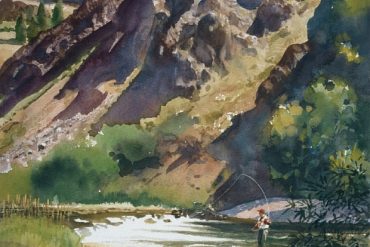
Eric Harrison with his 51-pound 2017 Striper Cup Catch & Release entry
Want to join? Then heed the advice of these distinguished members and get into your first 50-pound striper.
Every sport has its pinnacle, an achievement that only happens when the stars align, and practice, persistence and opportunity come together in one impressive payoff. In baseball, it’s the perfect game. In golf, it’s the hole-in-one. In striped bass fishing, it’s the 50-pounder.
Many excellent fishermen have spent years and small fortunes searching for this trophy only to come up empty-handed, while just as many novice fishermen have booked a charter or strolled down to the sand and bested one of these impressive stripers without a full understanding of their accomplishment. It goes without saying that lady luck plays a role in the pursuit of the 50-pound striped bass, but some anglers seem to have figured out how to put luck on their side. The multiple second-grader-sized striped bass the following fishermen have put on the beach or in the boat have proven that these guys have gotten into the heads of super-sized stripers.

Home Waters: New Jersey
Credentials: Zwirko has boated numerous 50-pounders fishing from Virginia to Massachusetts.
Advice: “The best days are the roughest. When the water is whipped up, the fish are easier to fool.”
Few fishermen range as far in their pursuit of striped bass as Captain Ken Zwirko. Based in New Jersey, Zwirko follows the bass as far as Massachusetts in the summer and all the way down to Virginia and North Carolina in the winter. With a number of 40- and 50-pounders to his credit, and more that he has guided clients to, he has definitely figured out a thing or two about where and when to look for big bass.
Zwirko finds many of his trophy bass in the spring, when he looks for an indication of fish that is more often associated with offshore fishing: temperature breaks. “In late May and early June, the bays are much warmer than the ocean, so when that water pours out, it creates a temperature break that the big bass will follow,” Zwirko said.
The big spring stripers off New Jersey, Zwirko explained, are on the move, and may not be relating to structure at all. His goal is to intercept these fish as they migrate by drifting with live baits in the lanes the fish are following north. “You’re not always going to mark fish, because the fish aren’t staying in one place for long. I know that if you find bait in 50 or 60 feet of water, the bass are there because those are the depths through which the big bass like to migrate in the spring.”
Zwirko maintains that, with the bass on the move, it’s important to hold their interest. “Once you find the fish, you need to keep chumming or keep live baits in the water to keep the bass in the area. As soon as the easy meal is gone, the school of bass will keep heading north.”
Even in water as deep as 50 or 60 feet, Zwirko doesn’t fish baits on the bottom with heavy weights. He keeps the baits on the surface and said that the big stripers have no problem rocketing up from the depths to inhale a lively bunker.
Zwirko likes the nastiest conditions he can safely fish in his boat. According to Ken: “The best days are the roughest. When the water is whipped up, the fish are easier to fool.”
Zwirko attributed much of his success with monster stripers to the use of properly cared-for and well-prepared baits. “Bunker can lose their slime if you pack too many of them into a livewell,” Zwirko said. This not only affects the bait’s longevity and liveliness on a hook, but the bass actually have a more difficult time engulfing a dried-out bait. The slime on a well-cared-for bunker will help the bait slide down the striper’s throat “like a gumdrop,” and this will help the fisherman get a better hookset. Dried-out baits will be knocked around by the bass on the surface and may never be fully engulfed, leading to missed fish.

Home Waters: Long Island, NY
Credentials: Nine Surf-Caught 50-Pounders
Advice: “If you want to catch the really big fish, you’ll throw [menhaden] chunks.”
Alberto Knie takes his striped bass fishing seriously. He meticulously studies tide charts and carves out time around the new moon phases specifically to hunt for monster striped bass. As the 2010 season gets underway, Knie is looking for his tenth 50-plus-pound striped bass from the Long Island surf.
In discussing how to decipher what combinations of structure, conditions and technique offer the very best shot of encountering what he calls, “the one,” Knie used as an example a 2009 trip into the surf. With a fall storm approaching, Knie decided to roll the dice and fish an area he’d never before tried under that particular set of conditions. He knew the structure he’d be fishing had the potential to draw big fish, he knew the pre-storm conditions were just right to get the big bass in a feeding mood, and he knew the technique he would employ, chunking with fresh menhaden, offered him the best chance at the largest striped bass in the vicinity. The grand total of striped bass that he caught on that trip? Zero.
Knie’s reaction to the trip may come as a surprise: “The trips when you don’t catch anything are just as important as the ones where you catch fish,” he said. He explained that unless he’d gotten out there and tried that specific location in those conditions, he wouldn’t have been able to cross that spot off the list next time such a set of conditions arose.
Though Knie agrees that you can’t rule out any set of conditions, he does think that stormy weather gives anglers a better shot at encountering the striper of their dreams. “The early part of a storm, when the water is rough but not dirty, is the time to look for that big fish,” Knie said. They know that once the water gets dirty, they won’t be able to feed for a couple days, so they turn on before the storm.”
As for technique, Knie said he isn’t afraid to get down and dirty to catch giant stripers. When asked his opinion on the best way to hook a 50-pounder, Knie replied: “If you want to catch the really big fish, you’ll throw [bunker] chunks.”

Home Waters: Beaches of Cape Cod, Massachusetts
Credentials: Stetzko beached two 60-pounders and a 73-pound Massachusetts State record.
Advice: “The most important thing is knowing where the bait is.”
You can count on one hand the number of 70-pound stripers caught from the surf in the past 100 years, and one of those fish belongs to the late Cape Cod surfcaster Tony Stetzko. His 73-pound striped bass is at the top of an impressive list of surf-caught…

